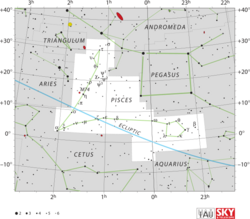Astronomy:Sigma Piscium
| Observation data Equinox J2000.0]] (ICRS) | |
|---|---|
| Constellation | Pisces |
| Right ascension | 01h 02m 49.09645s[1] |
| Declination | +31° 48′ 15.3471″[1] |
| Apparent magnitude (V) | +5.50[2] |
| Characteristics | |
| Spectral type | B9.5V + B9.5V[3] |
| U−B color index | −0.20[4] |
| B−V color index | −0.04[4] |
| Astrometry | |
| Radial velocity (Rv) | 10.4 ± 0.9[5] km/s |
| Proper motion (μ) | RA: 14.33[1] mas/yr Dec.: −30.25[1] mas/yr |
| Parallax (π) | 8.86 ± 0.07[1] mas |
| Distance | 368 ± 3 ly (112.9 ± 0.9 pc) |
| Orbit[3] | |
| Period (P) | 81.12625 ± 2.7 d |
| Semi-major axis (a) | 5.56 ± 0.04 mas |
| Eccentricity (e) | 0.8956 ± 0.0020 |
| Inclination (i) | 143.4 ± 1.3° |
| Longitude of the node (Ω) | 167.8 ± 1.7° |
| Periastron epoch (T) | MJD 31308.153 ± 0.023 |
| Argument of periastron (ω) (secondary) | 346.6 ± 2.0° |
| Semi-amplitude (K1) (primary) | 53.2 ± 1.9 km/s |
| Semi-amplitude (K2) (secondary) | 59.6 ± 1.6 km/s |
| Details[3] | |
| σ Psc A | |
| Mass | 2.65 ± 0.27 M☉ |
| σ Psc B | |
| Mass | 2.36 ± 0.24 M☉ |
| Other designations | |
| Database references | |
| SIMBAD | data |
Sigma Piscium (Sigma Psc, σ Piscium, σ Psc) is a main-sequence star in the zodiac constellation of Pisces. It has an apparent magnitude of +5.50, meaning it is barely visible to the naked eye, according to the Bortle scale. While parallax measurements by the Hipparcos spacecraft give a distance of approximately 430 light years (133 parsecs),[1] dynamical parallax measurements put it slightly closer, at 368 light-years (113 parsecs) from Earth.[3]
Sigma Piscium is a spectroscopic binary system, meaning the components of the system have been detected from periodic Doppler shifts in their spectra. In this case, light from both stars can be detected and it is double-lined. It has an orbital period of 81 days, and the orbit is relatively eccentric, at about 0.9. Both components are B-type main-sequence stars.[3]
Sigma Piscium is moving through the Milky Way at a speed of 23.5 km/s relative to the Sun. Its projected galactic orbit carries it between 24,300 and 29,400 light years from the center of the galaxy.[6]
Sigma Piscium was a latter designation of 40 Andromedae.[7]
Naming
In Chinese, 奎宿 (Kuí Sù), meaning Legs, refers to an asterism consisting of σ Piscium, η Andromedae, 65 Piscium, ζ Andromedae, ε Andromedae, δ Andromedae, π Andromedae, ν Andromedae, μ Andromedae, β Andromedae, τ Piscium, 91 Piscium, υ Piscium, φ Piscium, χ Piscium and ψ1 Piscium. Consequently, the Chinese name for σ Piscium itself is 奎宿十 (Kuí Sù shí, English: the Tenth Star of Legs.)[8] Sigma Piscium, however, is also identified with Kuísùzēngshíwǔ (奎宿增十五), the 15th additional star in the Legs asterism.[9]
References
- ↑ 1.0 1.1 1.2 1.3 1.4 1.5 van Leeuwen, F. (2007). "Validation of the new Hipparcos reduction". Astronomy and Astrophysics 474 (2): 653–664. doi:10.1051/0004-6361:20078357. Bibcode: 2007A&A...474..653V. http://www.aanda.org/index.php?option=com_article&access=bibcode&Itemid=129&bibcode=2007A%2526A...474..653VFUL.
- ↑ Ducati, J. R. (2002). "VizieR Online Data Catalog: Catalogue of Stellar Photometry in Johnson's 11-color system". CDS/ADC Collection of Electronic Catalogues 2237. Bibcode: 2002yCat.2237....0D.
- ↑ 3.0 3.1 3.2 3.3 3.4 Konacki, Maciej; Lane, Benjamin F. (2004). "The Visual Orbits of the Spectroscopic Binaries HD 6118 and HD 27483 from the Palomar Testbed Interferometer". The Astrophysical Journal 610 (1): 443–455. doi:10.1086/421037. Bibcode: 2004ApJ...610..443K.
- ↑ 4.0 4.1 Mermilliod, J.-C. (1986). "Compilation of Eggen's UBV data, transformed to UBV (unpublished)". Catalogue of Eggen's UBV Data. Bibcode: 1986EgUBV........0M.
- ↑ Wilson, Ralph Elmer (1953). "General catalogue of stellar radial velocities". Carnegie Institute Washington D.C. Publication. Bibcode: 1953GCRV..C......0W.
- ↑ "Sigma Piscium (HIP 4889)". Archived from the original on 14 April 2014. https://web.archive.org/web/20140414170254/http://www.astrostudio.org/xhip.php?hip=4889.
- ↑ Wagman, M. (August 1987). "Flamsteed's Missing Stars". Journal for the History of Astronomy 18 (3): 211. doi:10.1177/002182868701800305. Bibcode: 1987JHA....18..209W.
- ↑ (in Chinese) AEEA (Activities of Exhibition and Education in Astronomy) 天文教育資訊網 2006 年 5 月 19 日
- ↑ :zh:奎宿增十五
 |


